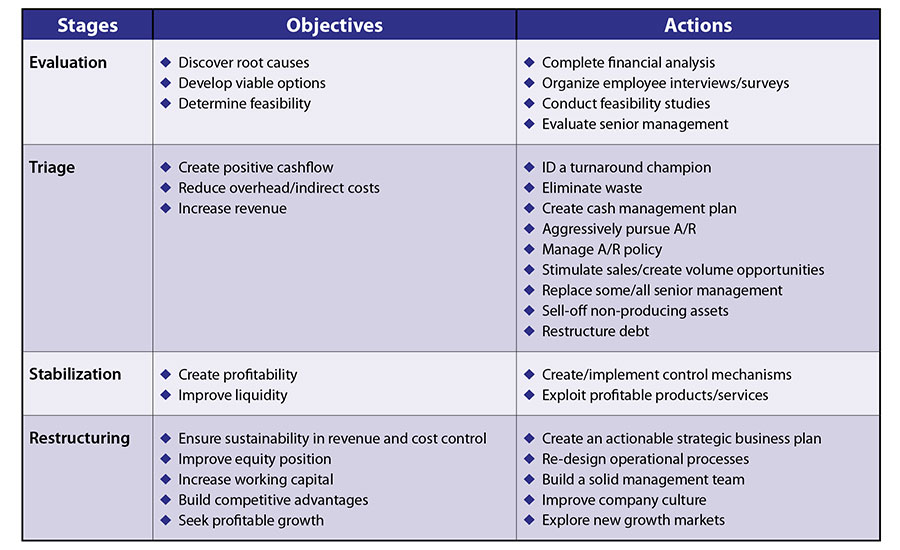4 Stages of Saving a Failing Business | Part 1

Almost seven years ago, during the later hours of a Friday afternoon, I was wrapping up some paperwork and feeling pretty good about the progress of the week. My wife and I had a sitter lined up for the evening, and I was looking forward to date night with dinner and a ballgame. That’s when the call came in. It was one I thought I would never get from a client, but there it was. “Tim, I can’t make payroll and I don’t know what to do.”
My client was having a rough year with his growing restoration business. Sales were in a slump, his house was mortgaged to the hilt, the line of credit was maxed out, and credit cards were run to the limits. The shakiness in his voice told me this was not only a dire situation, but one that could forever change the course of his future.
One of my least favorite engagements as a consultant is a turnaround. They are emotional rollercoasters full of sleepless nights, difficult conversations, copious financial analysis, and frequent surprises which are never welcome. And that’s just the consultant’s side of the situation. Imagine what it is like from the business owner’s perspective.
No one likes to be told their business in insolvent. Unfortunately, most owners wait until it already is before they seek help. This is, without a doubt, the reason why the success rate of turnarounds isn’t greater. And it’s only once business owners recognize and accept their reality that the work to turn the business around can begin.
Evaluation
The first stage in a turnaround involves a systematic and comprehensive evaluation of the business’ financial health, operational performance, and management effectiveness. It is a humbling and uncomfortable experience for most companies as they must strip down to examine the issues of the organization. This can be akin to a person who hasn’t been feeling well for a while and has a sinking feeling that something major is wrong, but is reluctant to go to the doctor because they don’t want to confront the reality of a serious illness.
The objectives during the evaluation stage are to discover the root causes of failure, develop options for moving forward, and determine the feasibility of those options. Depending on the degree of failure, options are usually limited to bankruptcy, downsizing, or additional capital investment. Each of these can be paired with a myriad of strategies to be effective, but they all require hard work and 100 percent commitment from the owner and managers of the business.

Triage
The most difficult and time-consuming stage of a turnaround is what we not so affectionately call “triage.” While we take no pride in this label, it is clearly the most appropriate when you consider the activities that take place during this period of time. The bleeding needs to be stopped and the vital functions of the business need be stabilized very quickly.
Taking deliberate action to eliminate waste, pursue accounts receivable, stimulate sales, and restructure debt can seem tireless at times. Anxiety runs high for months until progress can be measured. While the list of action items can be long and daunting, the objectives during this stage are simple: create positive cash flow, reduce overhead and indirect expenses, and increase revenue. This is the blood, oxygen, and food/water of the business.
One very important element to triage which cannot be overlooked is the people side. While the focus is on the vitals, someone needs to lead the charge and manage the procedures established to reach a stabilization point. This can be a real challenge, especially if most or all senior management staff is replaced. No one likes turnover — especially at the top. However, the reality of the situation is that these individuals were put into management positions to make the company succeed, not fail. And if it is failing, they are failing, and they should be replaced.
Almost every source you reference on this subject will recommend the importance of a turnaround “champion.” This person, usually not the owner, is the driver of the initiative. They need to be knowledgeable, trustworthy, and well respected in the company. Their purpose is twofold. First, to keep their eye on the pulse of the organization and make sure spirits remain high and optimistic. Second, to execute effectively on the action items established to bring life back to the company. This is not a pretty job but can be artistic when done correctly. Hence the label, “Turnaround Artist.”

Stabilization
Stabilization is what everyone wants as quickly as possible. It’s the point in the turnaround where the company starts breathing on its own again. Most often, stabilization happens in conjunction with triage, but it should not be confused with being a part of that stage. It is separate, and the objectives are different. While the triage stage is laser-focused on the vitals, the stabilization stage focuses on the health of operations by creating profitability and improving liquidity. These two facets are fundamentally important in preparing the organization for the final stage of restructuring that will lead the company out of the turnaround.
To create profitability and improve liquidity, activities must be focused first on creating and implementing management controls to maintain the corrective action taken in the triage phase. These can be new policies and procedures, meetings, and/or individual or group accountabilities. All these actions should create new levels of discipline in the organization necessary for survival under a new structure. Once the control mechanisms are in place, profitable service lines must be exploited aggressively. In other words, do more of what the company is good at and stop doing what it is not.
This promotion of profitable services should not be confused with trying to take corrective action on those services that are not profitable. For example, if a restoration company is really good at mold remediation services but less than profitable at repair work, it should aggressively pursue remediation services and turn away repair opportunities. This can be hard to do, especially if there are larger revenue opportunities with the repair side. At this stage, people will often say “we need to fix our repair division.” No, you need to do more remediation and less repairs until the company is stable enough to fix the repair division. Remember, the objective is profitability.

Restructuring
Finally, we get to the fun part. Restructuring in a turnaround can be invigorating, because a viable future is starting to take shape. Activities like business planning, operational process improvement, model development, improving company culture, and exploring new growth markets are all strategic in nature. After the business has been effectively stabilized, a whole new world of possibilities begins to emerge.
Efforts in the restructuring phase need not be limited by time, but they should be focused on accomplishing five objectives: establishing sustainability in revenue and cost control, improving the equity position, increasing working capital, building competitive advantages, and seeking profitable growth. Pulling these off requires a systematic approach involving every functional area of the business—from administration to sales and operations to human resources and accounting. All must be engaged in the process and working toward common goals.
I am happy to share that my client who couldn’t make payroll successfully navigated his way through all four of these stages. Today, he is thriving with an impressive bottom line, healthy cash flow, and an envious net worth. The turnaround process was anything but easy, but it was certainly worth it. These were just the mechanics, however. What it actually took on his part and through the efforts of his staff is another story. One that we will explore next month in part II of this article.
Looking for a reprint of this article?
From high-res PDFs to custom plaques, order your copy today!







